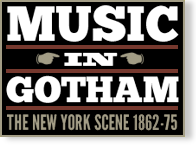Humpty Dumpty abroad
Event Information
Venue(s):
Grand Opera House
Price: $.50; $.50 extra reserved; $.40 family circle
Event Type:
Play With Music
Record Information
Status:
Published
Last Updated:
3 March 2025
Performance Date(s) and Time(s)
25 Nov 1873, 8:00 PM26 Nov 1873, 8:00 PM
27 Nov 1873, 1:30 PM
27 Nov 1873, 8:00 PM
28 Nov 1873, 8:00 PM
29 Nov 1873, Matinee
29 Nov 1873, 8:00 PM
Program Details
Scheduled to begin on Monday (11/24) but postponed to Tuesday (see announcements).
Performers and/or Works Performed
Citations
Full cast list. Plot synopsis. Includes a “grand ballet of instruments.”
“…It is said that almost five hundred people are to be employed in its [Humpty Dumpty] representation, and that quite fifty thousand dollars will have been spent in its getting up before the curtain rises…” No mention of music.
“Original music and choice popular arrangements of incidental by Mr. Strebinger.”
“A very large number of people were disappointed last night by finding the doors of the Grand Opera-house closed, and the announcement that the first performance of Mr. Fox’s new version of ‘Humpty Dumpty’ was postponed until this evening. It is understood that the cause of the delay was the very elaborate preparations necessary to the proper production of the pantomime. The carpenters and machinists were all busily at work last night, and ‘Humpty Dumpty Abroad’ will certainly be presented to the public this evening.”
“The production of Mr. G. L. Fox’s pantomime, ‘Humpty Dumpty Abroad,’ at the Grand Opera House last night, was postponed until this evening. The piece has been in incessant rehearsal, but the stage effects are so numerous and so complicated that it was deemed unsafe to hazard the production of the pantomime before everything was working satisfactorily.”
“…The ever-popular Martens sang with great approbation some of their songs and the ‘Cat Duet,’ which was vociferously called for again and again.” Long review; no other mention of music.
Long review. “…Variety is given to the piece…by the singing of the Martins [sic], who were encored repeatedly…and by the singing of the ‘famous California Quartet,’ who will not, probably, add to their fame in this representation, and can be conveniently omitted in shortening the piece.” No further mention of music.
Long; notes only standing room in house. “…The principal ballet in this act takes the shape of musical instruments…” No further mention of music.
Very long and negative review; includes full cast list. “…Considerable new scenery had been painted, and the only real novelty consisted of the Isle of Harmony, where the houses are built of musical instruments and the ladies and gentlemen wear costumes in close imitation of various instruments… In the third scene—the Palace of Instruments in the isle of Harmony—a ballet called Charavari and Instruments is given. Eight coryphees, attired like musical bells, execute a dance, during which they strike upon portions of their costumes with little wooden mallets, while a set of real bells in the orchestra emit the accompanying sound. The Rigl Sisters followed in a pas [sic] de deux. They gave place to a number of ladies attired as mandolins. Betty Rigl and Emily danced a grand variation; and a dance, which partook more of the nature of a march, by all the ladies representing various instruments, closed the ballet…[later in the piece] the Marten Family sang their well-known Tyrolean airs…” No further mention of music.

